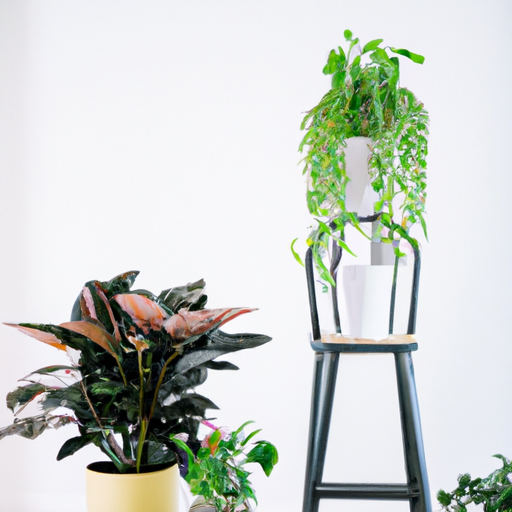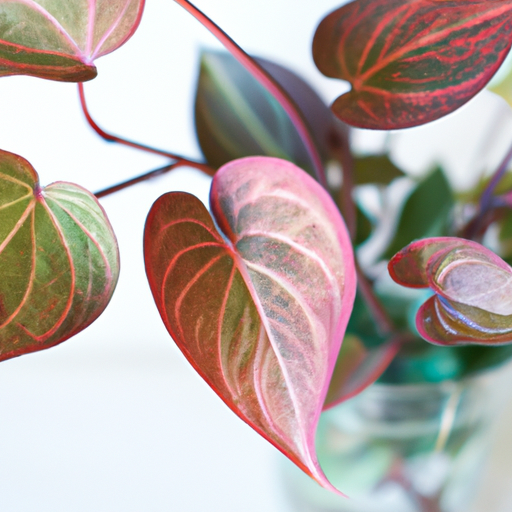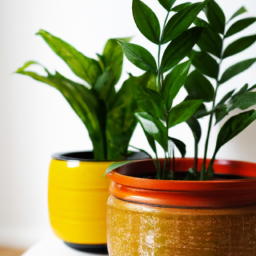
Are you looking to add some greenery to your home but not sure where to start? House plant pots are a great way to showcase your favorite indoor plants while also adding a touch of style to your space. Whether you’re a seasoned plant parent or just starting out, choosing the right pots for your house plants can make all the difference. In this blog post, we’ll explore the world of house plant pots and help you find the perfect containers for your beloved green friends. So grab a cup of tea, sit back, and let’s dive into the wonderful world of house plant pots!
Benefits of Using Different Types of House Plant Pots
Choosing the Right Material
When it comes to selecting the perfect house plant pot, the material plays a crucial role in the health and growth of your plants. Clay pots are a popular choice among plant enthusiasts due to their porous nature, which allows for better airflow and drainage. This helps prevent overwatering and root rot, ensuring that your plants thrive. Additionally, clay pots are known for their ability to absorb excess moisture, which can be beneficial for plants that require well-draining soil.
On the other hand, plastic pots are lightweight and durable, making them a practical option for indoor plants. They are also affordable and come in a variety of sizes and colors, making it easy to find the perfect pot for your plant. Plastic pots are non-porous, which means they retain moisture well and require less frequent watering. However, it is important to monitor the soil moisture levels to prevent waterlogged roots.
Another popular choice for house plant pots is ceramic. Ceramic pots are not only aesthetically pleasing but also provide good insulation for plant roots. They come in a wide range of designs and colors, allowing you to add a touch of style to your indoor space. Ceramic pots are heavier than clay or plastic pots, which can help prevent top-heavy plants from tipping over. However, it is important to choose a ceramic pot with drainage holes to prevent water from pooling at the bottom.
Size and Shape Matters
When selecting a house plant pot, size and shape are important factors to consider. The size of the pot should be proportionate to the size of the plant, allowing room for growth without restricting the roots. A pot that is too small can stunt the growth of the plant and lead to root-bound issues, while a pot that is too large can cause water to accumulate, leading to root rot.
The shape of the pot can also impact the growth of the plant. Tapered pots are ideal for plants with deep roots, as they provide ample space for root development. On the other hand, shallow pots are suitable for plants with shallow roots, such as succulents and cacti. Hanging pots are a great option for trailing plants, allowing them to cascade down and create a stunning visual display.
It is important to consider the growth habits of the plant when choosing the shape of the pot. For example, plants that grow tall and upright may benefit from a taller pot to provide stability, while plants that spread out horizontally may thrive in a wider pot. Ultimately, the size and shape of the pot should complement the growth patterns of the plant to ensure optimal health and vitality.
Drainage and Maintenance
Proper drainage is essential for the health of your house plants, as it helps prevent waterlogged soil and root rot. When selecting a pot, ensure that it has drainage holes at the bottom to allow excess water to escape. If the pot does not have drainage holes, you can create them yourself using a drill or hammer and nail. Additionally, adding a layer of gravel or pebbles at the bottom of the pot can help improve drainage and prevent soil compaction.
Regular maintenance of your house plant pots is also important to ensure the longevity of your plants. Clean the pots regularly to remove any debris or mineral deposits that can accumulate over time. This will help prevent pests and diseases from affecting your plants. Additionally, repotting your plants every year or two can help refresh the soil and provide room for root growth.
By choosing the right material, size, and shape of house plant pots, you can create an optimal environment for your plants to thrive. With proper drainage and maintenance, your plants will flourish and bring beauty and life to your indoor space. So, next time you’re shopping for house plant pots, consider these factors to ensure the health and vitality of your beloved plants.
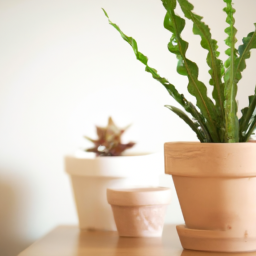
Choosing the Right Size and Material for Your House Plant Pots
Size Matters
When it comes to choosing the right size for your house plant pots, there are a few key factors to consider. First and foremost, you’ll want to make sure that the pot is large enough to accommodate the roots of your plant. If the pot is too small, the roots may become overcrowded and the plant may not be able to thrive. On the other hand, if the pot is too large, the soil may retain too much moisture, leading to root rot.
Another important consideration when choosing the size of your house plant pot is the size of the plant itself. A small plant will look lost in a large pot, while a large plant may become top-heavy and unstable in a small pot. As a general rule of thumb, choose a pot that is about 1-2 inches larger in diameter than the current pot your plant is in.
In addition to the size of the pot itself, you’ll also want to consider the depth of the pot. Some plants, such as succulents, have shallow root systems and do not require a deep pot. Others, like ferns, have deep roots and will need a pot with more depth. Make sure to choose a pot that provides enough room for your plant’s roots to grow and spread.
Material Matters
When it comes to choosing the material for your house plant pots, there are several options to consider. Each material has its own advantages and disadvantages, so it’s important to choose one that best suits your needs and the needs of your plants.
One of the most common materials for house plant pots is terra cotta. Terra cotta pots are porous, which allows air and moisture to pass through the sides of the pot. This can be beneficial for plants that require good drainage, as it helps prevent waterlogged soil. However, terra cotta pots can also dry out quickly, so you may need to water your plants more frequently.
Another popular option for house plant pots is ceramic. Ceramic pots come in a wide range of colors and designs, making them a great choice for adding a decorative touch to your home. They are also less porous than terra cotta pots, which can help retain moisture in the soil. However, ceramic pots can be heavy and may break more easily than other materials.
Plastic pots are another common choice for house plants. Plastic pots are lightweight, durable, and affordable, making them a practical option for many plant owners. They are also available in a wide range of sizes and colors, making it easy to find the perfect pot for your plant. However, plastic pots are not as breathable as terra cotta or ceramic pots, so you’ll need to be careful not to overwater your plants.
In conclusion, when choosing the right size and material for your house plant pots, it’s important to consider the needs of your plants as well as your own preferences. By taking the time to select the perfect pot, you can help ensure that your plants thrive and add beauty to your home.
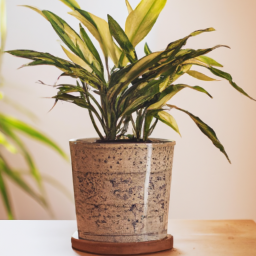
Creative Ways to Decorate Your Home with House Plant Pots
Welcome to our guide on creative ways to decorate your home with house plant pots! House plants are a wonderful way to bring nature indoors and add a touch of greenery to your living space. But why settle for plain old terra cotta pots when you can get creative and make your plant display truly unique? In this article, we will explore some fun and innovative ways to decorate your home with house plant pots.
Painted Pots
One of the simplest ways to add a pop of color and personality to your house plant pots is by painting them. You can use acrylic paint, spray paint, or even paint markers to create unique designs on your pots. Get creative with patterns, geometric shapes, or even paint your pots to match your home decor. Painting your pots is a fun and easy DIY project that can really make your house plants stand out.
When painting your pots, be sure to use a primer first to help the paint adhere to the surface. You can also seal your painted pots with a clear sealant to protect the design from water damage. Don’t be afraid to experiment with different colors and techniques to create a one-of-a-kind look for your house plants.
In addition to painting the outside of your pots, you can also paint the inside for a fun surprise when you water your plants. This is a great way to add a pop of color to your plant display without overwhelming the space.
Upcycled Containers
Another creative way to decorate your home with house plant pots is by upcycling old containers into planters. Instead of throwing away empty cans, jars, or even old boots, why not turn them into unique plant pots? Not only is upcycling environmentally friendly, but it also adds a touch of whimsy to your plant display.
To upcycle containers into plant pots, simply clean them out and add drainage holes if necessary. You can paint or decorate the containers to match your decor, or leave them as is for a more rustic look. Upcycled plant pots are a great conversation starter and can add a personal touch to your home.
Get creative with your upcycled plant pots by mixing and matching different containers and plants. You can create a cohesive display by grouping similar containers together, or go for an eclectic look by mixing and matching different styles and sizes.
Hanging Planters
If you’re short on space or want to add some visual interest to your walls, hanging planters are a great way to decorate with house plants. There are a variety of hanging planters available, from macrame hangers to wall-mounted planters to ceiling hooks.
When choosing hanging planters, consider the weight of your plants and the strength of the hooks or brackets you will be using. You can create a vertical garden by hanging multiple planters at different heights, or create a focal point by hanging a single large planter in a prominent spot.
Hanging planters are a great way to add greenery to small spaces, such as kitchens, bathrooms, or bedrooms. They can also be used to create a natural room divider or add a touch of nature to outdoor spaces like balconies or patios.
Essential Points
House plant pots are an essential element in creating a beautiful and thriving indoor garden. The right pot can not only complement the aesthetic of your plants but also provide the necessary environment for their growth. When choosing a pot for your house plants, it’s important to consider factors such as size, drainage, and material. Opt for pots that are slightly larger than the plant’s current container to allow room for growth, and ensure that there are drainage holes at the bottom to prevent overwatering.
In addition to functionality, house plant pots also offer an opportunity to showcase your personal style and creativity. From sleek and modern designs to quirky and colorful options, there are endless possibilities when it comes to choosing the perfect pot for your plants. Consider mixing and matching different pots to create a cohesive and visually appealing display, or experiment with unique shapes and textures to add interest to your indoor garden. Ultimately, house plant pots are not just a practical necessity, but also a chance to express your individuality and enhance the beauty of your home.
Here are some FAQs you’d be interested in:
Q1. What are the best types of pots for house plants?
A1. When choosing pots for your house plants, consider factors such as drainage, material, and size. Terra cotta pots are great for plants that prefer drier soil, while plastic pots retain moisture well. Ceramic pots are stylish and come in various colors and designs.
Q2. How often should I repot my house plants?
A2. It is recommended to repot your house plants every 1-2 years, or when you notice the roots becoming root-bound. Look for signs such as roots growing out of the drainage holes or the plant becoming top-heavy.
Q3. How can I choose the right size pot for my house plant?
A3. When selecting a pot size for your house plant, choose one that is 1-2 inches larger in diameter than the current pot. This allows room for growth while preventing the plant from becoming stressed due to being too cramped.
Q4. What are self-watering pots and are they beneficial for house plants?
A4. Self-watering pots have a reservoir at the bottom that allows the plant to absorb water as needed. These pots can be beneficial for house plants, especially if you tend to forget to water regularly. They help maintain consistent moisture levels for your plants.
Q5. How can I prevent overwatering my house plants in pots?
A5. To prevent overwatering your house plants, ensure that your pots have proper drainage holes at the bottom. Use a well-draining potting mix and water your plants only when the top inch of soil feels dry to the touch. Avoid letting your plants sit in standing water, as this can lead to root rot.
Emily Bloomfield is an interior designer and horticulturist specializing in incorporating indoor plants into interior spaces. With a background in both design and plant science, Emily offers a unique perspective on creating harmonious living environments through the synergy of greenery and aesthetics. Her creative ideas and innovative solutions make her a sought-after authority in the field.

